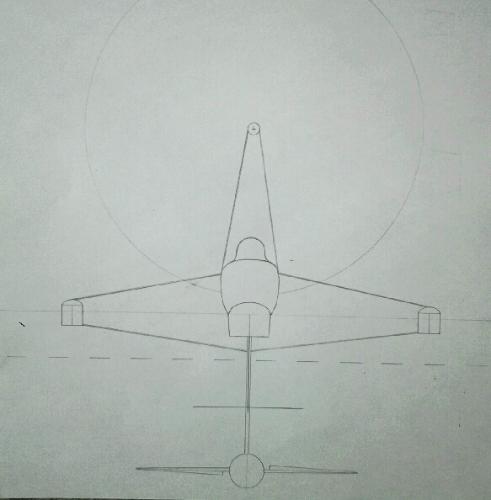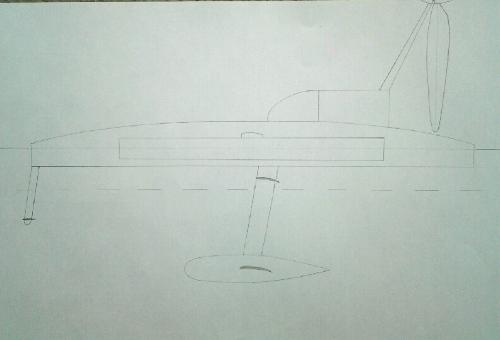CCC 2013
12345678
12345678
|
|
AirGlider
Thanks Jeremy From your recommendations I think I have all the design points for the hull covered. I am now starting on the design and construction of the low drag coating which is in the boat name. I am attempting to design a AIR DRAG REDUCTION SYSTEM in which air is pumped under the hull to form a very thin continuous film. This is not a system using bubbles as these only reduce the drag by a relatively low amount, where as a ALDR system can create a reduction of 80% on the treated area. Air is being fed via a slot to 140 ports discharging towards the stern at a exit velocity of around 25 m/s. The required air flux was taken from work by the University of Michigan, but my boat is smaller and slower than their test model, so a lot of guess work has been used. At first I thought of designing a high pressure fan for the air but than concluded that the drills do not run fast enough. A good cordless LEAF BLOWER could just about meet the requirements so this is what is being tried with the air being fed via a duct to the discharge ports. Having dreamed this system up, I do wonder if the boat could go faster with simply 2 drills but attempting to use air is more interesting. Dennis. |
|
|
In reply to this post by BrianP
If the hull is long enough and the displacement low enough, then you can probably get to quite high Froude numbers before the hull starts to plane. A lot will depend on the hull shape, if it's relatively flat bottomed then it will start to generate lift and get on to the plane at a lower speed. If it has a rounded bottom then the lift coefficient will be lower, so it will take a higher speed to get on to the plane.
I'm not quite sure how high a Froude number you could get to and still remain in displacement mode, probably somewhere around 2.5 to 3 for a very long, thin, light boat I would think. Catamarans are a special case, because although they are relatively inefficient at low speeds, at high speeds they behave more like a monohull with around twice the waterline length. The change in hull resistance with speed is complex, but in part is a function of the reduced wave interference between the hulls as speed increases; they literally leave their bow waves (in the horizontal axis normal to the hull primary axis) behind as they speed up. |
|
|
Here's a lines plan of the AC45.
http://chevaliertaglang.blogspot.de/2012/04/americas-cup-ac45-plans-ac45-lines-and.html Quite a flat bottom for max speed, but also slightly rounded for light wind speed. If all you wanted to do was go as fast as poss I guess a flatter bottom would be better. And more our scale of thing (18'), an A Class cat http://dnacat.blogspot.co.uk/2010_04_01_archive.html Look at the photo of the transom - very flat. Max speed is achieved with one just hull clear of the water. John |
|
|
In reply to this post by Jeremy
As I understand it (which may be completely out) the reason why long thin hulls don't have a hull speed limitation is that almost all of the resistance comes from skin drag rather than wave effects, which is proportional to the square of the velocity.
This means that the power required varies with the cube of the velocity. In practice, the result is more or less the same: you can get any hull (short and fat or long and thin) humming along nicely with very little effort, but to go even a little bit faster requires monstrous backbreaking breathtaking muscle-crippling exertion. But it is that little bit faster that wins races. |
|
|
Pretty much spot on. The reason for the wave resistance remaining low is because a long boat doesn't ride up its own bow wave until it reaches a greater speed, it can remain supported at both ends over a wider range of speeds. Once the boat is going fast enough that the wave departs from the aft edge of the waterline then the hull is no longer as evenly supported in the water and will pitch up as it tries to climb the bow wave, so increasing resistance. |
|
|
This post was updated on .
Thanks to Paul and Greg for getting me through the SPAMMER GATE and good day from the south west coast
of Canada! My condolences to Jeremy for his health glitch and pending house build. Good luck Jeremy! I would dearly love to compete in this years Cordless Canoe Challenge but unless somebody steps up to sponsor my entry... and that's just not going to happen. Or I could win the lottery but I don't buy tickets so that's not going to happen either. Instead, I'd like to offer up a collaborative, team build approach. There are many keen, courteous, seemingly capable people here on this thread let alone on the whole forum. There is strength in numbers and being of British ancestry, I'd be honoured to work with any one of you on this. Even if we just kick the design around a bit and see how it develops. I have an extensive marine background and several builds and designs under my belt, a real mix of theoretical and practical, but that's not so important. It's more about what we all bring to the table collaboratively. There is power in numbers! Jeremy and I have spoken about this competition before and here is one design approach I had to get the ball rolling. Cheers!
-Tom
|
|
|
This post was updated on .
Well, that didn't post very well, no images.

-Tom
|
|
|
This post was updated on .
Lol, challenging...

-Tom
|
|
|
That looks interesting Tom - are you trying to compete with the Moth?

|
|
|
No. Interestingly enough, this was drawn before I really investigated the moth. Nice website you have. -Tom P.S. Have you seen this little goody from the Dutch solar canal races? On Jan 16, 2013 1:28 PM, "adminHBBR [via UK HBBR Forum]" <[hidden email]> wrote:
That looks interesting Tom - are you trying to compete with the Moth?
-Tom
|
|
|
Too radical for you, sorry folks.
How about something based on a kayak... 
-Tom
|
|
|
Water cooled drills...no... tough audience.
Okay, how about something in between then:  There we go, air and water props! Cheers, have a great weekend.
-Tom
|
|
|
Tom, build it and send it over - we'll drive it for you!
I don't think international collaboration will work because we are all individuals who want to "prove" that our own idea is the best. |
|
|
Are you over 12 years of age and under 90 pounds? That's the kind of driver I'd be looking for. Well, if any of the 75+ who viewed my posts decide they want in, let me know. I'm a good collaborator! And I love to win! But mostly, I like to have fun. Cheers! On Jan 18, 2013 1:37 PM, "Alan [via UK HBBR Forum]" <[hidden email]> wrote:
Tom, build it and send it over - we'll drive it for you!
-Tom
|
|
|
In reply to this post by Alan
Hi Alan
I agree with your comment that we all want to prove our own ideas even if they are not the fastest. Any way how is your air screw boat proceeding. Dennis |
|
|
I definitely think we have these projects to prove something to ourselves even if we don't know exactly what we're trying to prove, but we always learn something from them.
For the CCC I might just make more efficient propellers, which is what Dennis suggested ages ago. Or I could make a planing hull if I make a final decision very soon. I've refurbished my garage to make a very acceptable workshop but I'm reluctant to spend time out there when it is so cold. |
|
|
Drill Rev Counter
Hi Folks, does any one know a simple cheap method for finding the revs. of the drill when the boat is under power. Dennis |
|
|
If you have a camera which does high frame rate video, you could always put a mark on the chuck and film it.......otherwise I've found that something like this works really well (again put a reflective strip on the chuck and point). http://uk.farnell.com/_/at6/tachometer-digital/dp/1430722 . Can't possibly imagine why I know that.........;)
Cheers, Simon. |
|
|
You can also use a tacho from the radio control model hobby. I mention it because there are some which also measure watts etc. which you might find useful. I dismantled one of my drills and wired it with external hobby type connectors to take power measurements. Jeremy more elegantly inserted copper strips into the battery connectors to get voltage measurements.
|
|
|
In reply to this post by Alan
+1. After years of designing/doodling boats, my entry for the ccc will be the first I have ever built. However my approach is the complete opposite to some of the exciting ideas on here.......it is a simple pram dinghy which I can take my kids in rowing afterwards, inspired by a boat lying by the side of a Norwegian lake........ |
«
Return to General Discussion
|
1 view|%1 views
| Free forum by Nabble | Edit this page |


